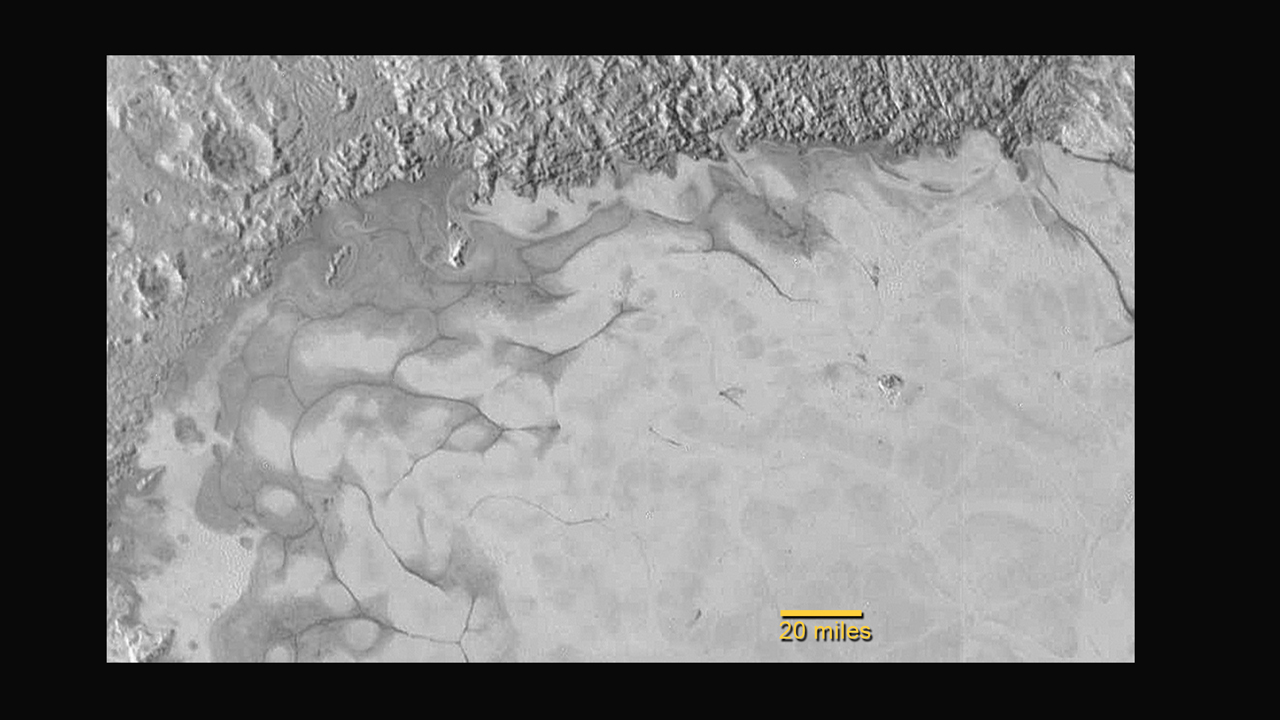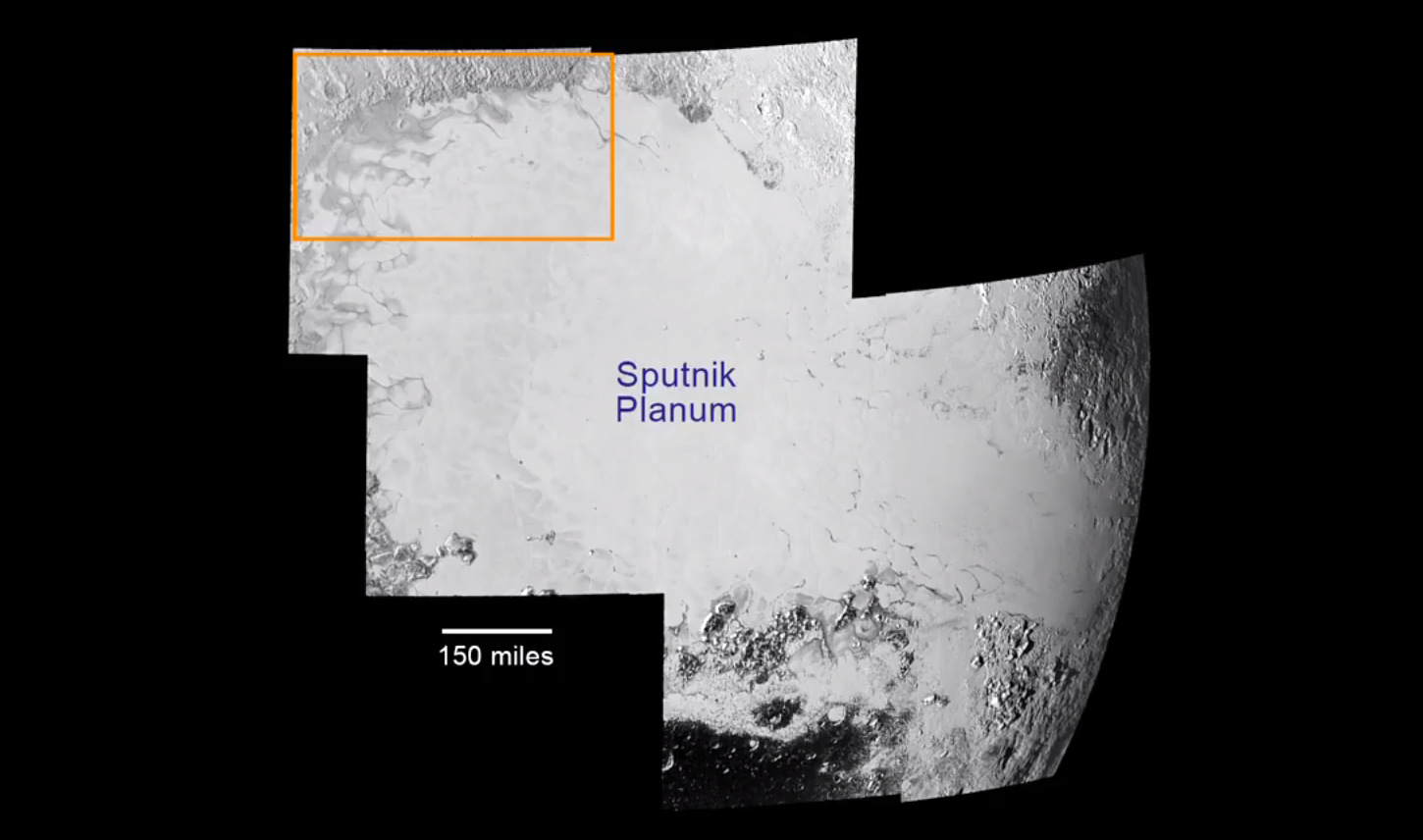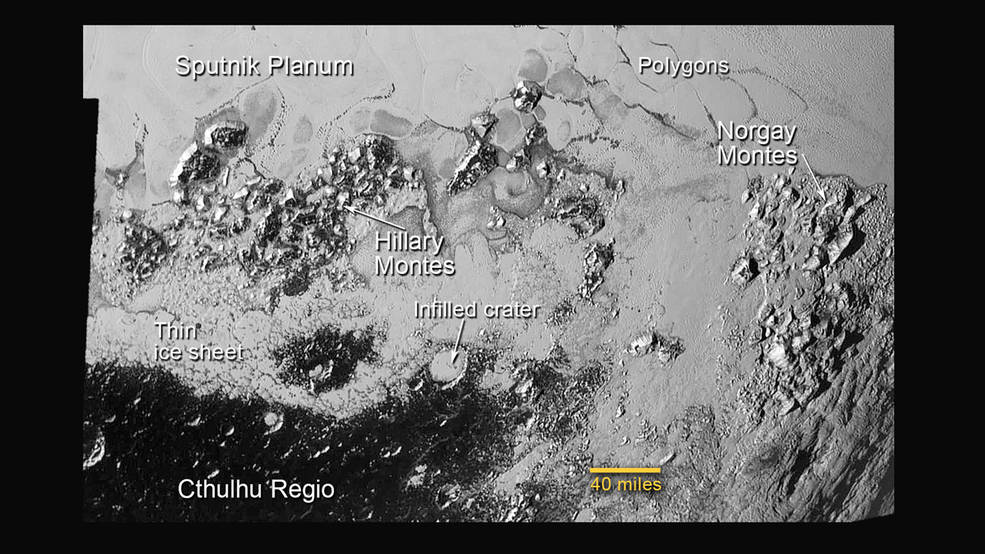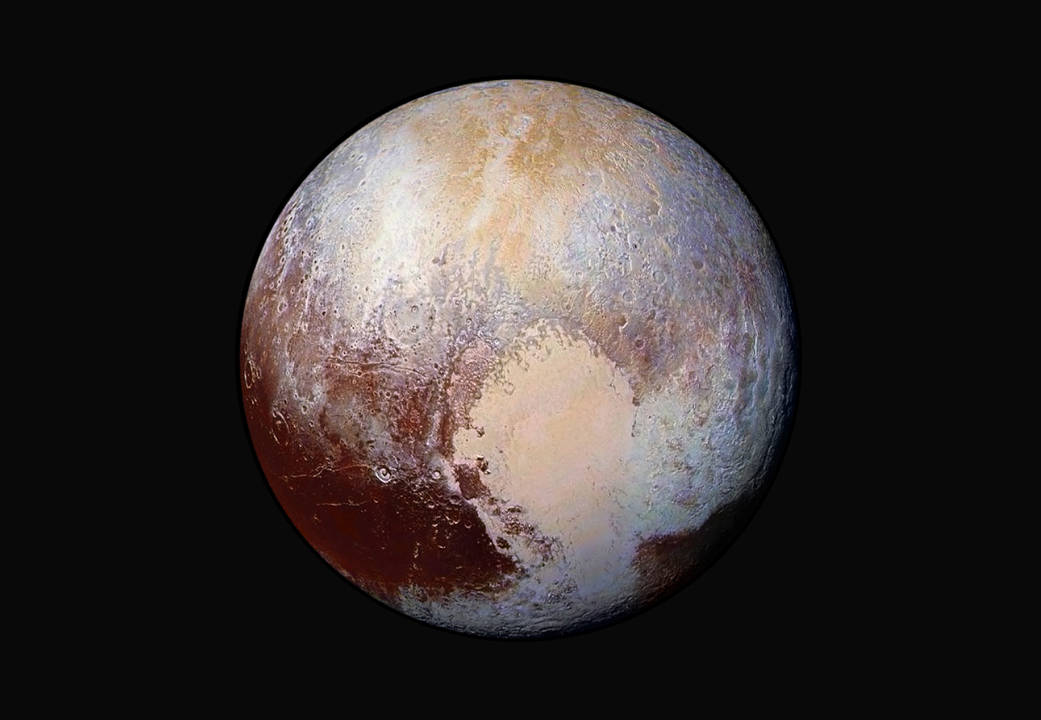Flowing Ices Reveal Recent Geological Activity in Pluto’s Heart-Shaped Region
by Sophia Nasr, @Pharaoness

The New Horizons media briefing on July 24th introduced us to a hauntingly beautiful image of a luminous atmospheric halo around Pluto and a number of new science findings. Of all the things I thought I would hear at the briefing, the revelation of exotic ices flowing across Pluto’s surface – indicating recent geological activity - was not one of them. There are ices flowing, I repeat, flowing, on Pluto's surface – a world some 5 billion km (3 billion miles) away from the Sun. Wow.
Exotic ices are just a fancy way of saying ices not commonly found on Earth. On Pluto these include ices made of nitrogen, methane, and carbon monoxide. These ices are able to exist on Pluto due to extremely low surface temperatures.
The Northern Region of Sputnik Planum
The flowing ices were discovered in the northern region of Sputnik Planum, in the "heart of the heart" of Pluto. Sputnik Planum is a vast Texas-sized region in Tombaugh Regio (the heart). The expanse can be seen in the following 7-image mosaic.

Enlarging the upper left of the mosaic (orange square) reveals a region some 400 km (250 miles) across.

The annotated image above shows the flow direction of the ices on Pluto, which seem to flow up towards the boundary of the rugged terrain located on the upper portion of the image. "You can actually see a pattern that indicates the flow of viscous ice towards the scarp, or cliff boundary, of the rugged terrain," said William McKinnon, New Horizons Co-Investigator, Washington University, St Louis, at the briefing. The ices flow in much the same way that glacial ice flows on Earth.
You might be wondering how it’s even possible for ices to flow on Pluto, with temperatures as low as 38 K (-235°C, or -390°F). It’s possible on Pluto because the flowing ices we see are not made of water ice, like those on Earth. These exotic ices are made up of constituents like nitrogen, methane, and carbon monoxide. "Water ice at Pluto’s temperatures won’t move anywhere, it’s immobile and brittle," said McKinnon. Further more, McKinnon said the ices on Pluto are "geologically soft, and malleable, even at Pluto conditions, and they will flow, in the same way that glaciers do on Earth. We have actual evidence for recent geological activity."
Exotic Ices
It’s fascinating to find ices flowing on Pluto. Let’s talk a little bit about why its possible for these ices to flow at such frigid temperatures. The reason why these types of ices can flow under such low temperatures is because these constituent ices have much lower freezing points—the temperature at which a liquid changes to a solid—compared to liquid water (H2O).
Water has a freezing point of 273 K (0°C, or 32°F), while nitrogen freezes at 63 K (-210°C, or -346°F). Methane and carbon monoxide freeze at higher temperatures than nitrogen, freezing at 91 K (-182°C, -296°F) and 68 K (-205°C, -337°F), respectively. Both nitrogen and methane have significantly lower freezing points than water. This is why ices on Pluto can still be malleable enough to flow. This is also why those ice mountains we see on Pluto have to be made of water ice - it’s the only thing that can get "hard" enough to build mountains that high. How those water ice mountains are built remains a mystery but an intriguing possibility is that water is flowing up from a liquid water ocean deep inside Pluto.
But what drives the ice flows? According to McKinnon it’s not sunlight, but rather Pluto’s internal heat. Internal heat drives convection, and convection makes stuff move, much like convection currents in the asthenosphere drive plate tectonics on Earth. But also, if ice (as long as it's under temperatures that allow them to be somewhat soft and malleable) is heavy enough, then the gravity it is subjected to, the pressure of its weight, will cause it to slowly move, or creep. A slope on the surface will also cause it to flow. "If you have a thick enough, a massive enough, layer of these kind of ices, whether it be nitrogen, or carbon monoxide, or methane, it will move. If there’s a sufficient slope, it will move," said McKinnon. There could also be a reservoir of liquid nitrogen below Pluto’s surface. "There may be even conditions where you can get liquid nitrogen flowing below a deep layer of ice of tens or hundreds of meters," said Alan Stern, New Horizons Principal Investigator, Southwest Research Institute, Boulder, Colorado, at the briefing.
The polygons you see in the image are likely formed by internal convective motion driven by Pluto’s internal heat. McKinnon stated that as long as the ices on Pluto are at least a half a mile deep (0.8 km), the convective process can operate. The "deformation" of the crust you see in the image isn’t caused by the ice flows alone. "We know that geological activity beyond just the flows have deformed the crust. We can’t fully explain what’s going on because we’ve only seen these seven images close up," stated McKinnon. When uncompressed data are returned, more of the story will be revealed.
Two New Mountain Regions And Ice Deposits
Next, we move to the lower region of Sputnik Planum, a region some 650 km (400 miles) across.

The new mountainous regions are named Hillary Montes and Norgay Montes, after Sir Edmund Hillary and Tenzing Norgay, who together summited Mt Everest in 1953. The mountains soar 1.6 km (1 mile) high, similar to the height of the Appalachian Mountains on Earth. The flowing ices seem to have surrounded Hillary Montes.
The darker region in the lower part of the image is part of the "whale" we saw a while back in an image New Horizons took when it was still days away from closest approach to Pluto, and is informally named the Cthulhu Regio, after the underwater character in the works of H. P. Lovecraft. It appears newer ice deposits have invaded this ancient and heavily cratered region. Notice that the structure of the ice between Cthulhu Regio and Hillary Montes is much finer than the ice that forms the polygons in the Planum. "That tells us that the ice in that intervening region between the mountains and Cthulhu is substantially thinner," explained McKinnon.
The flowing ices in the Sputnik Planum region tell us that this area is very young. "The age is only a fraction of the total age of the solar system, probably no more than a few tens of millions of years," said McKinnon.
A World of Exotic Ice Landscapes
The stunning false color image of Pluto below reveals the differences in composition and texture on Pluto's surface.

The composition of the image varies with latitude—the lower part, which represents the equatorial region, is dark, likely due to tholins created by the radiation of hydrocarbons in Pluto’s atmosphere. Moving up towards the pole, the colours are lighter owing to the existence of fresher ices.
Because Pluto has such an eccentric orbit, the amounts of sunlight it gets varies greatly as it moves from perihelion (its closest point to the Sun, which is about 30 AU) to aphelion (its farthest point from the Sun, which is about 50 AU). The north pole of Pluto is also tilted by about 120 degrees to its orbital plane. "Some parts are baked, like near the equator, and other parts receive these condensation of these ices, as you can see on the north pole here. And so we’ve got a differing pattern that you can see manifested on Pluto that we understand from modeling of the seasonal transport of these ices," explained Cathy Olkin, New Horizons Deputy Project Scientist, Southwest Research Institute, Boulder, Colorado, at the briefing.
Yet there’s one part of the image of Pluto that stands out and doesn’t follow the latitudinal variation explained above—the Tombaugh Regio. The Tombaugh Regio is full of nitrogen, methane, and carbon monoxide ices. But near Pluto’s northern pole, nitrogen and methane ices exist, but no carbon monoxide is observed. "[M]aybe what we’re seeing in Tombaugh Regio is a source region for some of these specific ices," said Olkin.
A Complex World
So there you have it. Pluto, a distant world some 5 billion km (3 billion miles) away from the Sun, has a structured atmosphere, ices flowing on its surface indicating recent geological activity, and perhaps even an internal ocean beneath its icy surface. Alan Stern commented on the complexity of Pluto, and said "On Pluto, we have a much more intimate and intricate interaction between geology, and the volatile transport, and the seasonal climate cycles, and those kinds of things. They’re forcing one another and feeding one another, and creating a very complicated and layered story about the planet’s history." So dynamic is the Pluto system that Stern said "It’s very hard not to call an object like this, of this level of complexity, an atmosphere, with potentially an internal ocean, certainly with complicated seasonal cycles, certainly a complicated system of moons, a planet."
One thing I can absolutely agree with is that Pluto is an incredibly complex world, one that has stunned the world with each new observation, bringing to light new things we never thought we’d see on an object in the outer reaches of the solar system.
Not enough Pluto for you? Take a tour of Sputnik Planum below (oh and it is very much worth every second).
 Sophia Nasr is an astrophysics student at York University. Actively involved in the astronomical community at York U, she is the President of the Astronomy Club at York University and a member of the team at the York University Observatory. She also is involved in university projects, and holds a position in research on dark matter at York U. Holding scientific outreach dear, Sophia is actively involved in social media outlets such as Facebook, Twitter, and Google Plus, where she shares with the world her passion for the universe and how it works.
Sophia Nasr is an astrophysics student at York University. Actively involved in the astronomical community at York U, she is the President of the Astronomy Club at York University and a member of the team at the York University Observatory. She also is involved in university projects, and holds a position in research on dark matter at York U. Holding scientific outreach dear, Sophia is actively involved in social media outlets such as Facebook, Twitter, and Google Plus, where she shares with the world her passion for the universe and how it works.







